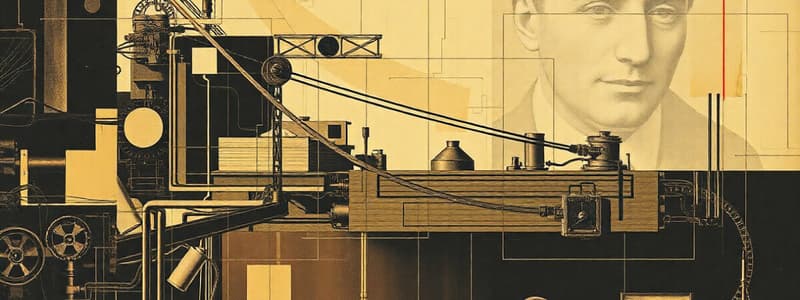Podcast
Questions and Answers
What does the distinction between sophistication of information processing and phenomenology imply about intelligence?
What does the distinction between sophistication of information processing and phenomenology imply about intelligence?
- Intelligence is an equal measure of both phenomenology and information processing.
- Intelligence is primarily a measure of information processing rather than phenomenology. (correct)
- Intelligence is primarily a measure of phenomenology rather than information processing.
- Intelligence cannot be comprised of either phenomenology or information processing.
What does the Turing Test aim to measure regarding machine intelligence?
What does the Turing Test aim to measure regarding machine intelligence?
- The consciousness of machines.
- The performance of machines without bias. (correct)
- The physical structure of machines.
- The emotional capacity of machines.
What is stated about Large Language Models in relation to machine intelligence?
What is stated about Large Language Models in relation to machine intelligence?
- They are the definitive standard for measuring all machine intelligence.
- They may pass as intelligent but are still not considered conscious. (correct)
- They have unanimously been accepted as conscious.
- They inherently possess consciousness due to their complexity.
How are computers fundamentally characterized in terms of their behavior?
How are computers fundamentally characterized in terms of their behavior?
What is suggested about the need for re-evaluating concepts of intelligence and consciousness?
What is suggested about the need for re-evaluating concepts of intelligence and consciousness?
What does Searle argue is necessary for understanding beyond algorithmic symbol manipulation?
What does Searle argue is necessary for understanding beyond algorithmic symbol manipulation?
What is the main point of the System Reply to Searle's Chinese Room argument?
What is the main point of the System Reply to Searle's Chinese Room argument?
What is Searle's response to the Robot Reply concerning the system's understanding?
What is Searle's response to the Robot Reply concerning the system's understanding?
What does Copeland argue in response to Searle's claim about individual understanding?
What does Copeland argue in response to Searle's claim about individual understanding?
How does Searle classify the type of intentionality exhibited by powerful LLMs?
How does Searle classify the type of intentionality exhibited by powerful LLMs?
In what context does Searle's argument about syntactic processing generating intrinsic intentionality hold more strongly?
In what context does Searle's argument about syntactic processing generating intrinsic intentionality hold more strongly?
What does the Robot Reply suggest regarding robots and intentionality?
What does the Robot Reply suggest regarding robots and intentionality?
What characteristic of chess-playing programs challenges Searle's argument?
What characteristic of chess-playing programs challenges Searle's argument?
What is the primary function of the read/write head in a Turing Machine?
What is the primary function of the read/write head in a Turing Machine?
In a Turing Machine, when does the machine stop processing?
In a Turing Machine, when does the machine stop processing?
What does Cantor's diagonalization demonstrate in relation to computable numbers?
What does Cantor's diagonalization demonstrate in relation to computable numbers?
How does Turing view the computer in the context of computation?
How does Turing view the computer in the context of computation?
What is a computable number?
What is a computable number?
What does the machine table in a Turing Machine accomplish?
What does the machine table in a Turing Machine accomplish?
Which of the following statements about computable numbers is true?
Which of the following statements about computable numbers is true?
In the context of Turing Machines, what role do states play?
In the context of Turing Machines, what role do states play?
What does Cantor's Diagonalisation method demonstrate about the set of real numbers?
What does Cantor's Diagonalisation method demonstrate about the set of real numbers?
How does Cantor's Diagonal Argument relate to Turing's concept of computability?
How does Cantor's Diagonal Argument relate to Turing's concept of computability?
What is Richard's Paradox primarily concerned with?
What is Richard's Paradox primarily concerned with?
What does a consistent logical system ensure?
What does a consistent logical system ensure?
What is meant by syntactic completeness in a logical system?
What is meant by syntactic completeness in a logical system?
What is the result of Cantorian tweaking on a list of real numbers?
What is the result of Cantorian tweaking on a list of real numbers?
Why is the concept of a meaningful English phrase problematic in Richard's Paradox?
Why is the concept of a meaningful English phrase problematic in Richard's Paradox?
What is the primary stance of Searle regarding the internal states of a robotic lumberjack?
What is the primary stance of Searle regarding the internal states of a robotic lumberjack?
Which aspect of computability does Turing’s work highlight regarding real numbers?
Which aspect of computability does Turing’s work highlight regarding real numbers?
According to Turing, what should be the primary criterion for assessing machine intelligence?
According to Turing, what should be the primary criterion for assessing machine intelligence?
What is a significant aspect of machine learning systems described in the content?
What is a significant aspect of machine learning systems described in the content?
What does Searle suggest is crucial in evaluating whether a machine demonstrates real intelligence?
What does Searle suggest is crucial in evaluating whether a machine demonstrates real intelligence?
Which argument aligns with Turing's perspective on machine intelligence?
Which argument aligns with Turing's perspective on machine intelligence?
What does the extreme exemplar interpretation of intelligence emphasize?
What does the extreme exemplar interpretation of intelligence emphasize?
What challenge is presented regarding systems that demonstrate sophisticated processing capabilities without consciousness?
What challenge is presented regarding systems that demonstrate sophisticated processing capabilities without consciousness?
What does Searle suggest about the differences between intelligent behavior and true understanding?
What does Searle suggest about the differences between intelligent behavior and true understanding?
Flashcards are hidden until you start studying
Study Notes
Cantor's Diagonalization
- Cantor's Diagonalization demonstrates that the set of real numbers is not enumerable.
- It works by assuming that all real numbers can be listed, then constructing a new number that differs from each number in the list at some position. This new number is not on the list.
Turing Machines and Computability
- Turing used similar reasoning to show that not all real numbers are computable by a Turing Machine.
- Turing Machines can only handle a subset of numbers (the computable ones), many real numbers cannot be computed algorithmically.
Richard’s Paradox
- Richard’s Paradox is a paradox that arises when considering definable numbers.
- It states that if we list all meaningful English phrases that describe a decimal number between 0 and 1, we can construct a diagonal number that differs from every number in the list.
- This number cannot be in the list, so it cannot be defined by any English phrase.
- However, by defining how to construct it, we did so in English, creating a paradox.
Logic and Computation
- A logical system is consistent if it is not possible to derive a contradiction within it.
- A logical system is syntactically complete if for any well-formed formula, either the formula or its negation is provable within the system.
- A Turing Machine consists of a tape, a read/write head, a set of states, and instructions in the form of a “Machine Table.”
- The Turing Machine starts in the initial state, with the read/write head positioned at the leftmost cell of the input on the tape.
- The machine stops when it reaches a halting state. The symbols remaining on the tape represent the output of the computation.
Turing Machine as a Model for Human Computation
- Turing described computation as the process of writing symbols on paper.
- The computer is viewed as a person following instructions.
- The machine simulates human calculation by executing simple steps like reading, writing, and changing states.
The Paradox of Computable Numbers
- A computable number is one whose digits can be generated by a machine following a set of instructions.
- Definable numbers may not be computable.
- Suppose there is a way to define real numbers between 0 and 1 by specifying methods for computing them.
- By applying Cantor's diagonalization, a new number can be constructed that differs from every number on the list.
- This new number is uncomputable, but the construction process suggests it is computable, creating a paradox.
Searle's Chinese Room Argument
- Searle’s argument is a strong challenge to computational theories of mind.
- The System Reply: the system of which the man is a part understands Chinese, even if the man himself does not. Searle argues that the system cannot get from the syntax to the semantics.
- The Robot Reply: If the system were embedded in the real world, like in a robot, it might develop semantic understanding. Searle counters that the robot still has no way of getting from syntax to semantics.
Possible Responses to Searle
- Intelligence Without Intentionality: even if an LLM has no intrinsic intentionality, its processing of information is “intelligent” on the basis of its impressive processing of relevant information.
- Intrinsic Intentionality in Abstract Domains: Searle’s argument is less convincing when considering “thought” about abstract entities. Systems like a chess-playing program, while not conscious, exhibit a form of intelligence.
- Going “Concrete” through Robotic Interaction? If we believe intentionality requires interaction with the physical world, robotic AI can achieve it, but Searle argues that the machine still lacks “understanding” in the sense of conscious awareness.
- Combining Robot and System Replies: The man in the Chinese room does not understand Chinese, but the system as a whole may.
What do Machines Lack?
- Searle will deny that robotic lumberjack's states have “semantic content," even with causal relations.
- His arguments suggest that “understanding” in the sense of conscious awareness is the crucial factor.
Intelligence and Consciousness
- Turing believed that machine consciousness is as reasonable as believing that other people are conscious.
- Intelligent thinking need not require consciousness.
- Searle argues that without conscious awareness, machine intelligent behavior is merely a product of syntactic manipulation.
- Machines can demonstrate sophisticated processing capabilities without consciousness.
Are Machines Conscious?
- Consciousness is a causally active process.
- The behavior of computers is well understood and there is no room for another causally active process.
- We do not understand our consciousness, but we do understand enough about how computers work to rule out their being conscious.
Computer Machinery and Intelligence
- The Turing Test provides a context in which a machine’s intelligence can be judged on the basis of performance alone.
- The issue of machine intelligence should be separated from that of consciousness.
- We can accept the possibility of genuine machine intelligence without believing in conscious machines.
Studying That Suits You
Use AI to generate personalized quizzes and flashcards to suit your learning preferences.




